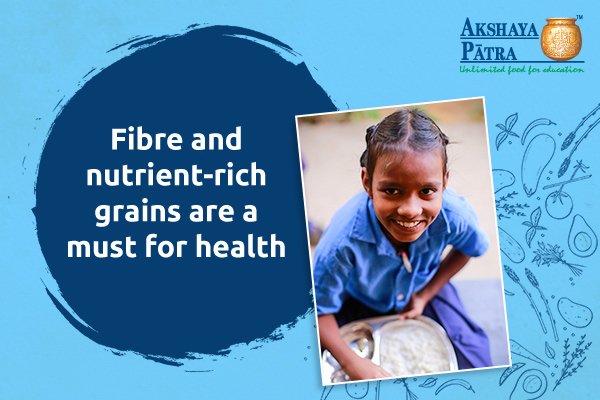
The modern Indian diet is very high in refined carbohydrates and low in proteins when compared with the traditional diet followed by our ancestors. It is a widely accepted fact that carbohydrates are an integral part of a traditional Indian diet and reintroducing carbohydrate-rich could be an important step in reducing the burden of disease in the population.
According to a popular saying, “You are what you eat.”
And the food that you eat influences your thought, activities and the energy that you revolve around. The staple food in most Indian households is Wheat, Rice, Jowar, Bajra, Ragi, Daliya (Broken Wheat). It is a common notion that these basic and nutritious foods are not as palatable and there are not too many options to explore in terms of variety. But the truth is that your body needs these vitamins and minerals for maintaining the production of healthy cells and by experimenting with different combinations of food, it can be exciting for the taste buds as well.
All thanks to access to information available on the internet, Millenials and Generation Z are more receptible to incorporating whole grains in their diets.
Did you know?
Indians are becoming more receptive to healthy food habits by accepting whole grains in their diet from bakery produce to fast food or food in restaurants.
What are Whole Grains?
Whole grains are the seeds or kernels that are the source of storage of important nutrients. It is an obvious fact that whole grains are extremely nutritious as they have more benefits than polished grain. The outermost covering (bran), the germ (embryo) and the endosperm (the layer between the germ and the bran) have positive effects on health. Bran contains fibre and vitamin B, the germ contains oils, vitamins, minerals, proteins and antioxidants.
Other benefits of adding whole grains to your diet
• Whole grains deliver essentials nutrients like fibre, minerals, proteins, plant compounds, etc.
• Whole grains lower the risk of heart diseases, which is the leading cause of death.
• Eating fibre-rich food prevents overeating and keeps you full for a longer time.
• Support healthy digestion and lowers the risk of constipation.
Combining cereal and grains in the Indian Diet
When it comes to traditional methods of cooking, an average Indian household will cook cereals, pulses, legumes and grains in a combination that can cater to the nutritional requirements of an individual. For example, Daliya Pongal, Millets upma, Bisi bele bath, Idli, Dhokla, Dosa, etc.
Cereals contain 6- 12% protein & provide more than 50% of the daily protein intake.
Cereals, particularly whole grains, are an important source of vitamin B in our diet
Parboiling (which includes soaking in water and steaming of paddy) results in a seepage of vitamins present in the outer layer into the grain. Hence milled and polished parboiled rice retains much of the vitamins. The same logic applies to extraction of wheat flour (viz., maida) and peeled millets.
Intervention of the Government of India
Malnutrition is a serious problem that the Government of India is trying to combat. Fortification is a process of adding key vitamins and minerals like zinc, iron, vitamin D, and A to staple food like salt, milk and rice to improve the nutritional content.
Rice fortification is a major intervention of the Government to address the problem of nutrition within a short period. Rice fortification is the process of adding micronutrients like folic acid, iron, and vitamin B12 to a regular grain of rice.
According to the Food Safety and Standards Authority of India (FSSAI), fortification is the process of deliberately increasing the content of essential micronutrients to increase the nutritional quality of food to provide benefit with minimal risk.
In the last 10 years, iron deficiency has contributed to 20% of maternal deaths in India.
Recognising the importance of health and nutrition right from a very young age, the Food Corporation India (FCI) and the Ministries of Women and Child Development and Education came up with various schemes like the Mid-Day Meal (MDM) Programme and Integrated Child Development Services (ICDS).
Supporting NGO for midday meal programmes, the Government provides fortified rice kernels to tackle anaemia and micronutrient deficiencies right from age 0.
Intervention of Akshaya Patra to help children develop healthy food habits
The Akshaya Patra Foundation is a non-profit organisation that runs the world’s largest NGO-run school meal programme, serving freshly cooked nutritious mid-day meals. NITI Aayog has identified certain districts of India with a high level of malnutrition and the Foundation serves meals in these areas. It currently serves wholesome meals to over 1.8 million children in 19,039 schools of 14 states & 2 union territories of India. This scale of the programme in itself is a validation of the Foundation's credibility and the public trust in the organisation resulting from strict adherence to good governance practices.
Healthy grains used by Akshaya Patra
Akshaya Patra has been using healthy grains to nourish children with wholesome meals. The Foundation started enriching its rice-based recipes using Fortified Rice Kernels - containing Iron, Vitamin B-12 and folic acid in 2016. They receive their fortified rice from the Government of India.
They also use rice, rice flakes, wheat flour (whole), wheat semolina, etc. in their recipes. Their major goal is to provide nutritious and hot cooked meals to children that will help them in their overall development – cognitive and physical.
Support Akshaya Patra and donate to NGO to feed mid-day meals to school–going children coming from challenging backgrounds. Food can be the reason why they turn up in school every single day, education follows when they stay there. This nutritious food cooked in the form of school meals, in turn, nourishes them.